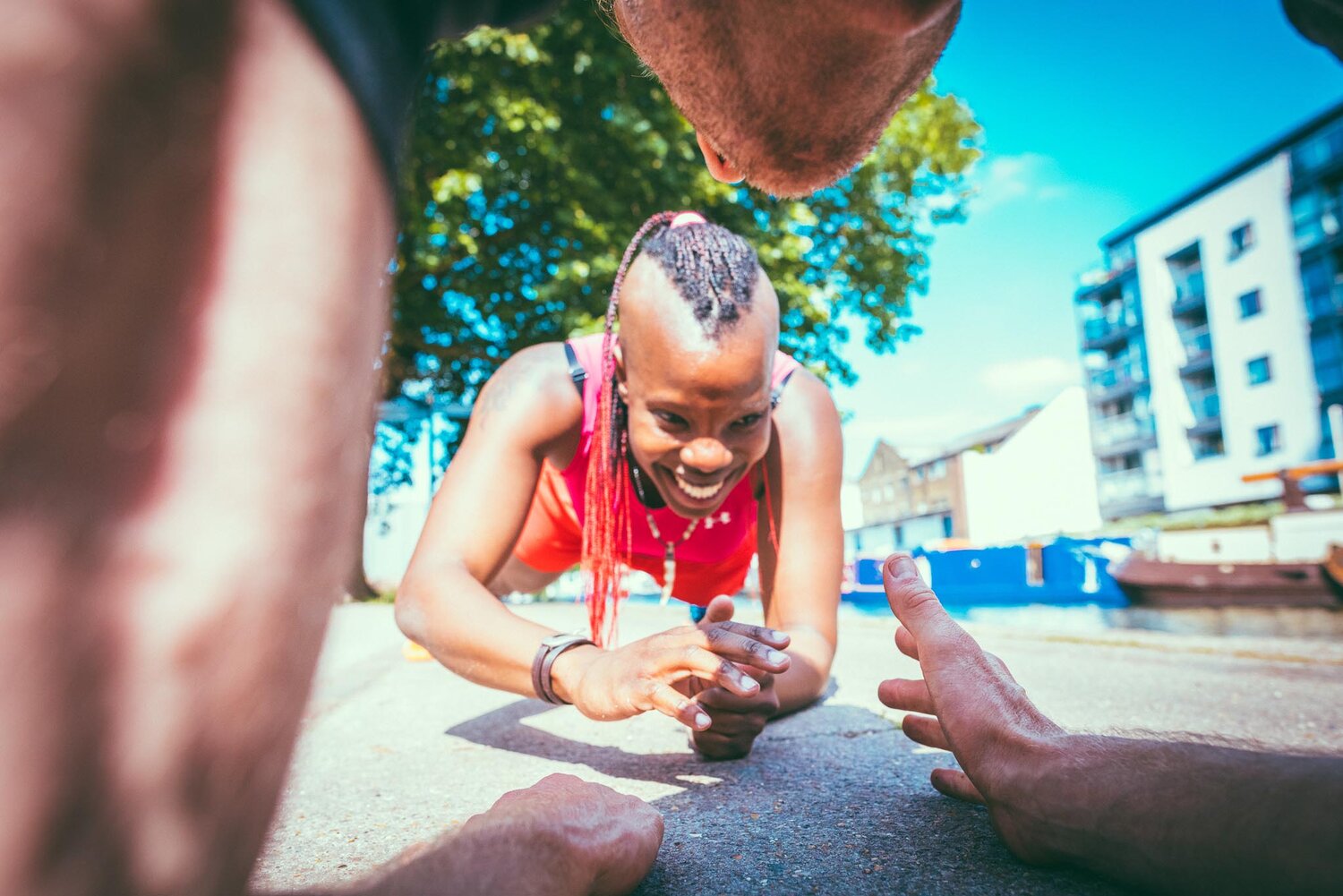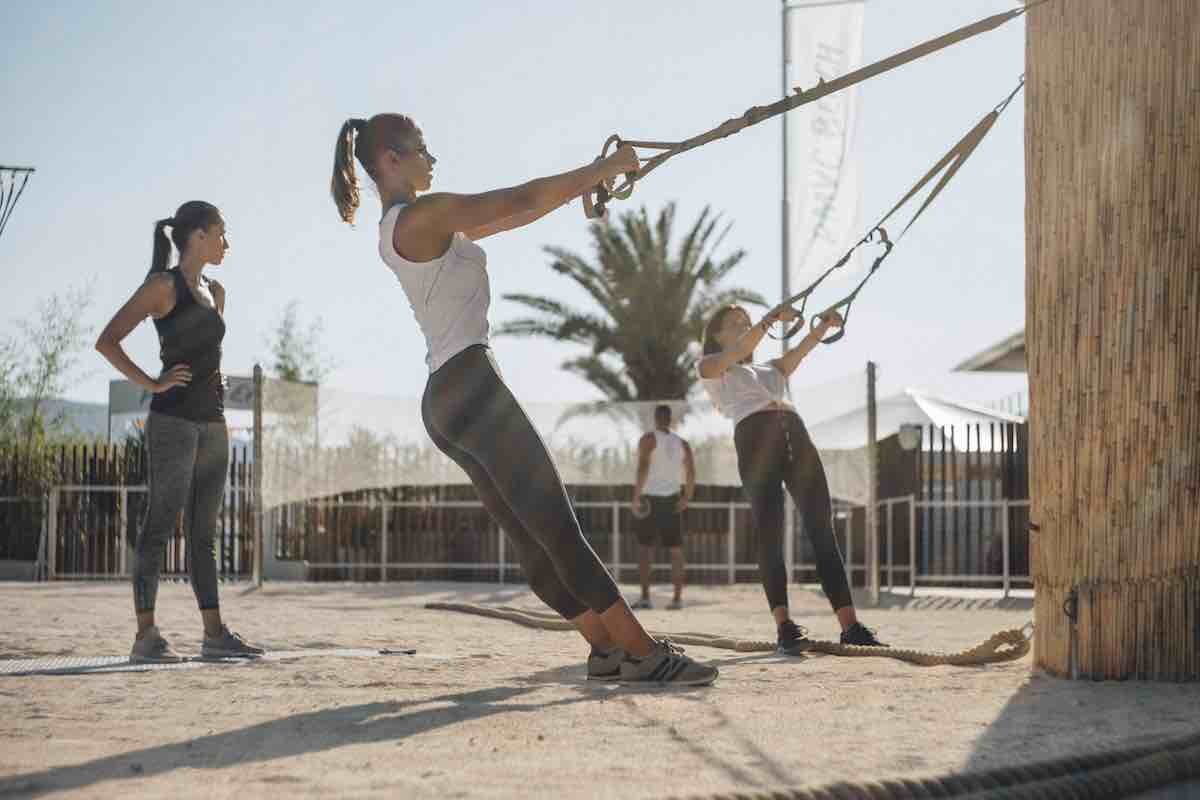OUR NATURAL FITNESS GROUP CLASS CONCEPT
Ideal for hotel fitness programs, workplace wellness & group workshops
Our natural fitness method was devised as a fun, challenging but ultimately accessible way to bridge the gap between the gym and the physical realities of outdoor activities.
So, what makes it ‘natural fitness’? We combine three key elements: bodyweight movements (such as crawls, rolls, get-ups and jumps) with functional fitness fundamentals (push, pull, squat, lunge, twist) and dynamic natural movements inspired by real world activities (running, swimming, martial arts, even surfing & tennis!).
Natural workout with no perfect sequences
This is natural fitness. We sweat, train hard and explore our limits. There are no shapes to be made, no fixed sequences. Life is short, let’s get to the point. You want to look good, move well and live pain-free. We get it.
Ideally we train outside in nature, or indoors in a nature gym or biophilic gym with plants, natural light, fresh air and organic materials… but we’ll take whatever we can get!
Nature is asymmetrical - natural fitness is too
When it comes to our natural method fitness, we look for ways to train asymmetrically using uneven loads, awkward foot positions and grips as well as dynamic drills that encourage the body to explore a wide movement vocabulary, especially when challenged by an external object or opponent.
It’s our unique take on General Physical Preparedness (GPP), helping you develop often neglected auxiliary skills such as hand-eye coordination, reaction times and grip strength, for example.
we have delivered group fitness classes in the UK, Sweden, Spain, Portugal, Canada & Montenegro
class sizes have varied from 3 to 30 in locations such as a resort, beach, park and urban riverside
the biofit fitness consultant’s glossary
-
A contemporary iteration of ‘aqua fitness’ with its connotations of 1980’s family holidays in ClubMed resorts to the sounds of YMCA on a nearby music speaker… today a new breed of Stand-Up Paddle-like rafts for indoor and outdoor pools provide a suitably unstable service for fitness classes, pilates and yoga. Ideal for resort pools, as well as health club pools with a group fitness program, this is a low impact, low risk class activity that engages the core stabilizers, guarantees plenty of laughter and will feel like less of a ‘workout’ than some group fitness concepts, meaning it can appeal to a different demographic.
-
A full-body, barbell-based group fitness class concept originally created by Les Mills as a dynamic, accessible workout for use in commercial gyms and health clubs as well as fitness studios. Expect uptempo music, light weights and high repetitions in the pursuit of lean, toned and athletic bodies. Class times are between 30 - 55 minutes. Gym equipment requirements include interchangeable barbells, weight plates, bands, an exercise mat and a step box.
-
A bodyweight only training style that is akin to gymnastic strength training (GST), ideal for upper body strength development and building a beast of a core in particular, while it often requires single leg or plyometric exercises to challenge the lower body to a similar extent. Positions such as the planche, front lever, back lever, L-Sit and handstand can be taken as medium-term goals to aim for while the real work is done in the lengthy series of step by step progressions to get there. Gym equipment requirements might include P-bars, pull-up bars, dip bars, rings, climbing rope and /or a calisthenics rig.
-
A wall-mounted, high-tech panel with mirrored glass that reflects the movements of a user, likely a home gym owner, whilst also showing a virtual trainer workout. This combination allows for A.I. feedback on form and movement during the workout, as well as adequate guidance and motivation to get through a training session while home alone with minimal gym equipment to hand.
-
A training style that aims to reconnect fitness with a modicum of real world purpose by focusing on the basics of lifting, carrying, climbing, hanging, manipulating objects through space, etc. Functional gym equipment might include ropes, medicine balls, sandbags, barbells and weight discs, sleds, kettlebells and calisthenics rigs. Functional gym or fitness studio design requires empty floor space and careful planning of perimeter storage rather than rows of strength or cardio equipment. Gym flooring such as rubber tiles or artificial turf provide extra comfort underfoot for functional training - white ‘sprint track’ markings entirely optional.
-
Either a live or virtual, instructor-led fitness experience for anywhere from 10-30 clients accompanied by music and a range of gym equipment such as mats, dumbbells, bands, balls and steps. Can also include spinning or yoga in some contexts, such as hotel or resort fitness programs aiming for a holistic, 360-approach. Gym design for a group fitness training area requires a combination of empty floor space and perimeter equipment storage, ideally planned down to the last dumbbell if we have anything to do with it!
-
Active (as opposed to static, or passive) stretching to work towards maximum range of motion, increasing flexibility and joint mobility while maintaining body control at all times. Mobility training might look more like high repetition micro-pulses, or repeated slow movements between one body position and another. The focus will be on opening up joints such as the neck, shoulders, Thoracic spine, wrists, hips and ankles, not just the flexibility of tendons and muscles. Gym equipment for mobility training might include foam rollers, yoga mats, bands, massage balls - all low cost, easily accessible equipment, making mobility a high return on investment!
-
The seemingly lost art of consistently using music as a strategic part of the gym experience, whether that be in group fitness classes, on the main gym floor or in the changing rooms or spa. Today, with artificial intelligence and the latest algorithms being what they are, there really is no excuse not to have gym music locked down tight. Legacy playlists that remain unchanged for decades and still feature “Macarena” or anything by Michael Jackson are no longer acceptable in boutique gyms, luxury hotel gyms or indeed anywhere that takes their music policy even half-seriously.
-
Going beyond strength and cardio training into the realms of body control, reaction times and agility. Typically involves visual and/or audio stimuli that require a physical response from the user such as moving to a new position, making a mental calculation in the brain first and then moving a limb or the entire body in response to that, and so on. Especially useful for sports performance, rehabilitation and ‘brain training’ for those with existing or possible future cognitive decline. Increasingly requires specific gym equipment with a tech / software component.
-
Obstacle Course Races (OCR) such as Spartan Race spawned their own specific type of gym design concept as a response to the increasingly wacky obstacles competitors are asked to navigate during a race. Expect monkey bars, climbing ropes, boxes and beams to climb over, running around the block, burpees, more burpees, more grip training and high-repetitions. It’s fun, doesn’t take itself too seriously and integrates elements of primal fitness such as crawls, jumps, loaded carries and so on. Gym equipment includes pull-up bars, grip handles, ropes, plyometric boxes, and a range of other pieces suspended from the ceiling to challenge your grip strength.
-
Training sessions led by an instructor that involve 3-6 clients, all befitting from a modicum of exposure to a PT, and a semi-personalized training experience while splitting the cost of that person’s time between them. Can be especially beneficial in an office gym setting where equipment (and motivation levels) may be limited during lunchtime workouts. From a gym operations perspective, a business model based on SGT can deliver tangible returns, as the price per hour is higher than for a 1-on-1 PT session, however it requires more floor space according to the number of participants.
-
A Virtual Trainer or Virtual Workout is streamed online in the format of either a live or pre-recorded class, via an app, or webpage, to a table, TV or smartphone, either to an individual training solo or to a group of people in which case it becomes more like a virtual group fitness class. The technology is evolving fast but key players in the market currently include Les Mills, Technogym, Peloton, Apple Fitness+ and iFIT. Some specialise in indoor training sessions, such as Technogym LIVE and Apple Fitness+, while others, such as iFIT, focus more on outdoor workouts in locations around the world to add visual interest and intrigue. Individual specialists also exist, such as Ergatta and Hydrow for rowing, although by now they have all added general strength, cardio, stretching and yoga classes as well to complete their offer.





